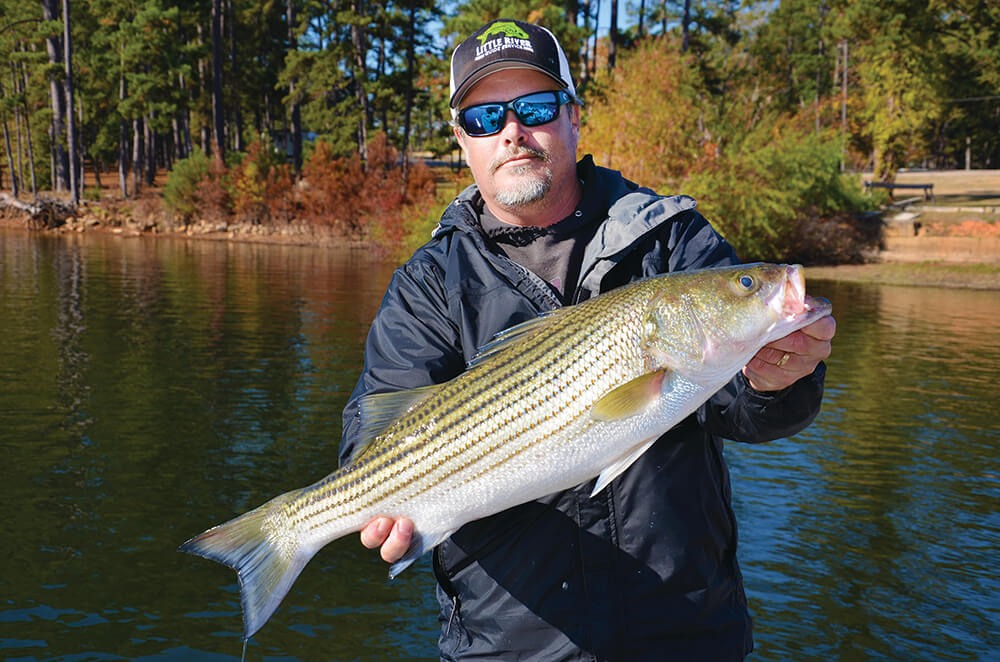Starting in the 1970s stocks of Atlantic striped bass in the Chesapeake Bay and the Roanoke River experienced unprecedented spawning failures. The cause of these annual spawning failures was overfishing, severely altered water flows during spawning time and poor water quality caused by pollution from numerous sources. In an effort to support striped bass stocks and fisheries until successful natural reproduction could resume in the Roanoke, Tar/Pamlico, Neuse and Cape Fear rivers, the U.S. Fish and Wildlife Service, the N.C. Division of Marine Fisheries, and the N.C. Wildlife Resources Commission initiated striped bass stockings into these coastal systems in 1980.
Since then, hundreds of thousands of striped bass of various sizes have been released annually into the Tar/Pamlico, Neuse and Cape Fear rivers on a rotating basis.
Q: What are the goals of the striped bass stocking  program?
program?
A: The goal of the stocking program is to augment the striped bass spawning populations and fisheries until self-sustaining populations can re-establish themselves and stocking is no longer necessary. This goal has already been met in the Albemarle/Roanoke system.
Q: Are the goals of the striped bass stocking program being met?
A: Yes and no. To evaluate if stocked fish contribute to the spawning population and fisheries, the N.C. Division of Marine Fisheries places internal anchor tags into 3,000 stocked fish in each river every year. A total of 9,000 fish are tagged annually. Tag returns have always indicated that stocked fish contribute to the spawning populations, but the exact contribution of hatchery fish to the total striped bass population cannot be determined from tagging alone. Starting in 2010, genetic techniques were employed to better calculate the contribution of stocked fish to the total striped bass population in all three systems.
Results so far indicate that nearly 100 percent of the fish returning to the spawning grounds are of hatchery origin. Beginning in 2016 and continuing this year, fin clips will be collected from fish harvested in the fisheries. The results will show a more complete idea of the hatchery contribution.
Things are different for the Albemarle/Roanoke stock. With stocking beginning in 1980, the Albemarle/Roanoke striped bass stock began successful natural reproduction by 1993. After several years of successful spawns, stocking in the Albemarle Sound ended in 1996. In 1997, the Albemarle/Roanoke stock was declared recovered.
Q: Why did the Albemarle/Roanoke striped bass stock recover and not the Central/Southern striped bass stocks?
A: North Carolina coordinated with Dominion Power and the U.S. Army Corps of Engineers to develop a water-flow plan that provides conditions as close to natural as possible in the Roanoke River during spawning season. Sufficient water flow is necessary to allow striped bass eggs to successfully hatch and be transported down the river to nursery areas in western Albemarle Sound. These changes increased the likelihood of successful reproduction of striped bass in the Roanoke River.
The same flow regime agreements are not in place for the Tar/Pamlico, Neuse, and Cape Fear rivers.
Q: Would the Central/Southern striped bass stocks recover if harvest was not allowed?
A: Although harvest is a critical component in the abundance of any fish stock, it is often not the most important factor in the cause of stock declines and poor annual spawning success. This is especially true for fish like striped bass that rely on coastal rivers for spawning habitat and the estuaries for juvenile nursery habitat. There has been a harvest moratorium on striped bass in the Cape Fear River since 2008.
While the total stock abundance and the abundance of older fish in the Cape Fear has increased, there have been no signs of improvement in annual spawning success. Important factors in the decline of Central/Southern striped bass stocks include loss of spawning habitat due to dams, poor water quality from residential pollution, industrial and agricultural development and severely altered water flow regimes during the spring spawning season.
Q: When will the striped bass stocking program in the Central/Southern river systems be reevaluated?
A: The most recent North Carolina Estuarine Striped Bass Fishery Management Plan was adopted by the N.C. Marine Fisheries Commission and the N.C. Wildlife Resources Commission in 2013. A review of the plan is scheduled to begin in 2018. Future striped bass management strategies in the Tar/Pamlico, Neuse and Cape Fear rivers, including the striped bass stocking program, will be a critical issue during the review process.

 program?
program?